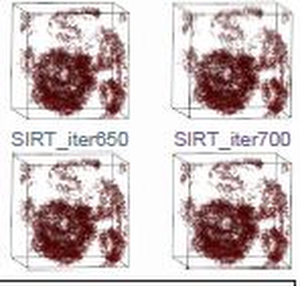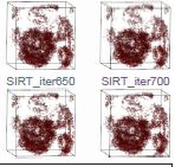Information
- Publication Type: Journal Paper (without talk)
- Workgroup(s)/Project(s):
- Date: January 2019
- Journal: IEEE TRANSACTIONS ON VISUALIZATION AND COMPUTER GRAPHICS
- Number: 1
- Open Access: yes
- Volume: 25
- Pages: 1040 – 1049
- Keywords: Ensemble data, comparative visualization, visual analysis, Hilbert curve, nonlinear scaling, X-ray computed tomography
Abstract
The comparison of many members of an ensemble is difficult, tedious, and error-prone, which is aggravated by often justsubtle differences. In this paper, we introduceDynamic Volume Linesfor the interactive visual analysis and comparison of sets of 3Dvolumes. Each volume is linearized along a Hilbert space-filling curve into a 1D Hilbert line plot, which depicts the intensities over theHilbert indices. We present a nonlinear scaling of these 1D Hilbert line plots based on the intensity variations in the ensemble of 3Dvolumes, which enables a more effective use of the available screen space. The nonlinear scaling builds the basis for our interactivevisualization techniques. An interactive histogram heatmap of the intensity frequencies serves as overview visualization. When zoomingin, the frequencies are replaced by detailed 1D Hilbert line plots and optional functional boxplots. To focus on important regions of thevolume ensemble, nonlinear scaling is incorporated into the plots. An interactive scaling widget depicts the local ensemble variations.Our brushing and linking interface reveals, for example, regions with a high ensemble variation by showing the affected voxels ina 3D spatial view. We show the applicability of our concepts using two case studies on ensembles of 3D volumes resulting fromtomographic reconstruction. In the first case study, we evaluate an artificial specimen from simulated industrial 3D X-ray computedtomography (XCT). In the second case study, a real-world XCT foam specimen is investigated. Our results show thatDynamic VolumeLinescan identify regions with high local intensity variations, allowing the user to draw conclusions, for example, about the choice ofreconstruction parameters. Furthermore, it is possible to detect ring artifacts in reconstructions volumes.I
Additional Files and Images
Additional images and videos
Additional files
Weblinks
BibTeX
@article{Weissenboeck_2019,
title = "Dynamic Volume Lines: Visual Comparison of 3D Volumes
through Space-filling Curves",
author = "Johannes Weissenb\"{o}ck and Bernhard Fr\"{o}hler and Eduard
Gr\"{o}ller and Johann Kastner and Christoph Heinzl",
year = "2019",
abstract = "The comparison of many members of an ensemble is difficult,
tedious, and error-prone, which is aggravated by often
justsubtle differences. In this paper, we introduceDynamic
Volume Linesfor the interactive visual analysis and
comparison of sets of 3Dvolumes. Each volume is linearized
along a Hilbert space-filling curve into a 1D Hilbert line
plot, which depicts the intensities over theHilbert indices.
We present a nonlinear scaling of these 1D Hilbert line
plots based on the intensity variations in the ensemble of
3Dvolumes, which enables a more effective use of the
available screen space. The nonlinear scaling builds the
basis for our interactivevisualization techniques. An
interactive histogram heatmap of the intensity frequencies
serves as overview visualization. When zoomingin, the
frequencies are replaced by detailed 1D Hilbert line plots
and optional functional boxplots. To focus on important
regions of thevolume ensemble, nonlinear scaling is
incorporated into the plots. An interactive scaling widget
depicts the local ensemble variations.Our brushing and
linking interface reveals, for example, regions with a high
ensemble variation by showing the affected voxels ina 3D
spatial view. We show the applicability of our concepts
using two case studies on ensembles of 3D volumes resulting
fromtomographic reconstruction. In the first case study, we
evaluate an artificial specimen from simulated industrial 3D
X-ray computedtomography (XCT). In the second case study, a
real-world XCT foam specimen is investigated. Our results
show thatDynamic VolumeLinescan identify regions with high
local intensity variations, allowing the user to draw
conclusions, for example, about the choice ofreconstruction
parameters. Furthermore, it is possible to detect ring
artifacts in reconstructions volumes.I",
month = jan,
journal = "IEEE TRANSACTIONS ON VISUALIZATION AND COMPUTER GRAPHICS",
number = "1",
volume = "25",
pages = "1040--1049",
keywords = "Ensemble data, comparative visualization, visual analysis,
Hilbert curve, nonlinear scaling, X-ray computed tomography",
URL = "https://www.cg.tuwien.ac.at/research/publications/2019/Weissenboeck_2019/",
}


 image
image
